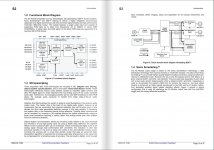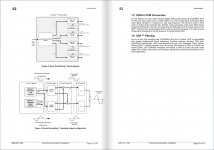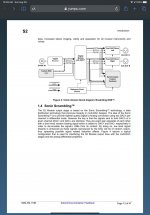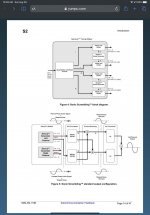I was suspecting scrambling technique used in Holo Audio when users reported that they could hear something like sea waves running in parallel with music. .
Thanks for that explanation. I've been wondering why May sounds so nice. Appreciated.
A quote from a book I learnt about digital processing my first time. 🙂If a tree falls in the woods, does it make a sound if there is no one to hear it?
I was still no such subject on the university.
You can easily remove dither by truncating word lenght, no DSP required. However what would be a reason for? I think you confuse dither removal with error randomisation.from page 14..
Can that D/A Converters section remove the dither in the digital domain..?? Or, the dither removal happens at the I/V Conversion stage?
As promised here is a resume of the tests performed by me since the beginning of this thread, including the last test.
When things should be added or corrected, please let me know.
Hans
.
Thank you for the final report Hans. I read it with interest since I could not participate in all experiments, but only the first one and the latest one.
It seems on this latest test, my listening impressions on 44 vs 88 were very different to the other NOS users (figure 5 in the report).
Cited from the report: "Quite obvious is that the NOS Dac users hear no difference between 44.1/16 and PGGB up-sampled 88.1/24 files, indicating that neither the frequency droop, nor the HF content directly above 22.05Khz is playing any role in sound perception."
I when I compared the 44 to the 88 in this final test, in my setup the sound difference was actually easier to hear, than the difference between 88 and 176.
Cited from report: "George found the 44.1/16 worse because they sounded a bit harsh. I think this is exactly what Doede and Hans heard, but depending on the rest of the installation, it may be reproduced differently."
With the 44 files, I also found them worse overall, but to me the 44 (compared to 88) sounded somewhat smoother and warmer, but a little less dynamic, and with less resolution, somewhat subdued cymbals etc.
Then with the 176 files, the added apparent resolution from the 88 files remained (and perhaps somewhat improved again) but the warmer, smoother character from the original 44, was back again.
So it seems to me the results are very difficult to generalize, and highly dependent on system/listener.
"seems to me the results are very difficult to generalize, and highly dependent on system/listener."
+1
+1
You can easily remove dither by truncating word lenght, no DSP required. However what would be a reason for? I think you confuse dither removal with error randomisation.
That is not how Sonic Scrambling works (as shown on page 14)... i.e according to the diagram, the dither noise is removed by relying on CMRR principles.
from page 14..
Can that D/A Converters section remove the dither in the digital domain..?? Or, the dither removal happens at the I/V Conversion stage?
I think it's the latter. If I'm right, the amount of dither removal will depend on the CMRR capability of I/V Converter...(OP amp) which will vary widely; in other words, that dither will never be removed to a satisfactory degree, which may explain why added dither actually sounds bad.
If I'm wrong, how can two DAC's (independent DAC's within the same die) ever be able to remove common-mode dither??
Attachments
Last edited:
@Thom, your feedback is mostly matching my opinion on upsampling in SoX, I made a while ago. A perceived improvement of upsampled resolution and dynamics is in result of missing some timbre and texture which is more present in 44.1k file. It may be less damaging with PGGB upsampling, I am still unable to evaluate it properly, may be later.
A cymbals problem of the 44.1k file is exactly the same what is cited from the report as a 'harshness'. It indicate that the analogue amplification chain is distorting HF images. Most likely is in result of using opamps in the I/F conversion stage. My opinion on cymbals is different, in my current gear there are actually more soft and natural when playing the original file. A public ovation is more three-dimentional, it is like sitting inside a venue.
@Extreme_Boky, thanks for screenshots.
A cymbals problem of the 44.1k file is exactly the same what is cited from the report as a 'harshness'. It indicate that the analogue amplification chain is distorting HF images. Most likely is in result of using opamps in the I/F conversion stage. My opinion on cymbals is different, in my current gear there are actually more soft and natural when playing the original file. A public ovation is more three-dimentional, it is like sitting inside a venue.
@Extreme_Boky, thanks for screenshots.
Last edited:
Interesting read, thanks! 🙂
No words on noise shaped dither by the way?
Fedde
Not about coloured noise used as dither, except that it exists and is useful for image processing. I simply don't know much about the subject.
I wrote a thing or two about noise shaping in my valve DAC article, https://linearaudio.net/sites/linearaudio.net/files/03 Didden LA V13 mvdg.pdf The rule of thumb for the noise gain only applies to systems with single-bit quantizers, you can use higher noise gains in the multibit case.
Last edited:
On the first thought, this is right.I think it's the latter. If I'm right, the amount of dither removal will depend on the CMRR capability of I/V Converter...(OP amp) which will vary widely; in other words, that dither will never be removed to a satisfactory degree, which may explain why added dither actually sounds bad.
On the second thought, an added dither may be exceeding linearity errors. Such large amount will be sefl-canceled after conversion, leaving (I expect) linearity errors randomized. Clever. It can be sea weaves heard in the result.
Still busy reading other screenshots.
Also dependent on the listener's mood, listening position, expectation &... etc. There are so many variables that without controlling those, it (subjective listening impression) is not a reliable evaluation metric to use. Just because some audio businesses are using it for marketing purpose doesn't make it any better.So it seems to me the results are very difficult to generalize, and highly dependent on system/listener.
...I when I compared the 44 to the 88 in this final test, in my setup the sound difference was actually easier to hear, than the difference between 88 and 176.
Not speaking for Hans, and while I haven't yet collected all of my thoughts regarding the 176.4 experiment results, I can say that it makes sense that you might hear a greater incremental difference between 44.1 and 88.2, than between 88.2 and 176.4. Because, the ZOH based 20kHz droop is approximately -3.17dB at an 44.1 rate, -0.75dB at an 88.2 rate, and -0.2dB at an 176.4dB rate. Therefore, the 20kHz droop difference between 44.1 and 88.2 rates is 2.42dB, and between 88.2 and 176.4 rates is 0.55dB. An incrementally much smaller change between 88.2 to 176.4 sample rates.
So it seems to me the results are very difficult to generalize...
Yes. In fact, Hans and I expected no subjective difference, aside from the net 0.55dB treble droop variance, between PGGB 88.2 and 176.4 upsampling. For either rate, all image-band frequencies are pushed well up in to the ultrasonic. We suspect that other resampling software settings may be responsible, such as dither.
Also dependent on the listener's mood, listening position, expectation &... etc. There are so many variables that without controlling those, it (subjective listening impression) is not a reliable evaluation metric to use. Just because some audio businesses are using it for marketing purpose doesn't make it any better.
Nevertheless, I do think the experiments are interesting and help to understand more about the topic, like the initiative was aiming to.
It is not controlled scientific experiments but nobody claimed that.
Not speaking for Hans, and while I haven't yet collected all of my thoughts regarding the 176.4 experiment results, I can say that it makes sense that you might hear a greater incremental difference between 44.1 and 88.2, than between 88.2 and 176.4. Because, the ZOH based 20kHz droop is approximately -3.17dB at an 44.1 rate, -0.75dB at an 88.2 rate, and -0.2dB at an 176.4dB rate. Therefore, the 20kHz droop difference between 44.1 and 88.2 rates is 2.42dB, and between 88.2 and 176.4 rates is 0.55dB. An incrementally much smaller change between 88.2 to 176.4 sample rates.
Yes. In fact, Hans and I expected no subjective difference, aside from the net 0.55dB treble droop variance, between PGGB 88.2 and 176.4 upsampling. For either rate, all image-band frequencies are pushed well up in to the ultrasonic. We suspect that other resampling software settings may be responsible, such as dither.
Yep, and that I percieved the 44 to be subdued in cymbals and a bit warmer/softer would make sense from the 20 kHz droop perspective.
I cannot understand though why I percieved the 88 as a little colder/harsher
but the both the 44 and the 176 as warmer/smoother. If not maybe as you say, there was some other processing parameter that changed between 88 and 176
...Also dependent on the listener's mood, listening position, expectation &... etc. There are so many variables that without controlling those, it (subjective listening impression) is not a reliable evaluation metric to use...
Not reliable? I think, yes and no, regarding that question.
Not reliable for the purpose of utilizing the indicated findings to dictate the set features a person should, or shouldn't absolutely want in their next DAC. For the purpose of encouraging someone to subjectively evaluate certain non-typical DAC implementation features or approaches for themselves, however, I feel that the group findings are helpful. Think of them as more a collection of anecdotal listening evaluations utilizing the same controlled sets of test files. Which, necessarily, were the only experiment system aspects which we had control over.
Last edited:
Thank you for the final report Hans. I read it with interest since I could not participate in all experiments, but only the first one and the latest one.
It seems on this latest test, my listening impressions on 44 vs 88 were very different to the other NOS users (figure 5 in the report).
Cited from the report: "Quite obvious is that the NOS Dac users hear no difference between 44.1/16 and PGGB up-sampled 88.1/24 files, indicating that neither the frequency droop, nor the HF content directly above 22.05Khz is playing any role in sound perception."
I when I compared the 44 to the 88 in this final test, in my setup the sound difference was actually easier to hear, than the difference between 88 and 176.
Cited from report: "George found the 44.1/16 worse because they sounded a bit harsh. I think this is exactly what Doede and Hans heard, but depending on the rest of the installation, it may be reproduced differently."
With the 44 files, I also found them worse overall, but to me the 44 (compared to 88) sounded somewhat smoother and warmer, but a little less dynamic, and with less resolution, somewhat subdued cymbals etc.
Then with the 176 files, the added apparent resolution from the 88 files remained (and perhaps somewhat improved again) but the warmer, smoother character from the original 44, was back again.
So it seems to me the results are very difficult to generalize, and highly dependent on system/listener.
However this is pretty much my impression. A bit exaggerated dynamics with 88,2 then smoothed with 176,4 but still different from 44.1. It has been a learning curve for me, I could only feel the difference when I compared all three versions. Perhaps it is important to add that I never heard the sinc droop through these tests. But I may perceived this as a change in dynamics after all...
Yep, and that I percieved the 44 to be subdued in cymbals and a bit warmer/softer would make sense from the 20 kHz droop perspective.
I cannot understand though why I percieved the 88 as a little colder/harsher
but the both the 44 and the 176 as warmer/smoother. If not maybe as you say, there was some other processing parameter that changed between 88 and 176
Hi Thom,
The last test was about comparing 88.2 to 176.4.
Earlier on the 44.1 versus 88.2 was already done, so I didn't want to start all over again with 44.1 but only gave some general info's on the 44.1 version.
Since I'm collecting comments, I will still make some additions to the report and will add the 44.1 comments including yours to the earlier 44.1 versus 88.2 test, that keeps things more together.
Hans
P.S. So for everybody, please give further suggestions for additions or corrections.
Ok, yes then we had similar subjective impressions.
I am quite impressed by the PGGB upsampling. I did not expect an improvement. I have tried realtime SoX upsampling in JRiver before and that always resulted in worse sound for me.
I am quite impressed by the PGGB upsampling. I did not expect an improvement. I have tried realtime SoX upsampling in JRiver before and that always resulted in worse sound for me.
Hans, yep I saw it was a separate experiment, that I did not participate in at the time.
Thanks.
Thanks.
Hans, you've identify the exact question which I'm hoping that Marcel can answer. When dither reduces a DAC's distortion, does such reduction manifest within the DAC, or only externally by error averaging within a spectrum analyzer, or a listener's ears? Sort of like the old Zen question of; If a tree falls in the woods, does it make a sound if there is no one to hear it? If dither randomizes the non-linearity of a DAC, is the distortion actually reduced if there is no one to hear it?
If the Anagram technique were to actually work, it seems that the distortion of any given DAC could be removed by the application of however much dither amplitude is required, then have the original SNR restored by the their dither noise subtraction technique. Which makes me suspect that it may not actually work.
Hi Ken,
I've put the Anagram technique in a LTSpice sim, where I constructed Tri dither from two independent square dither sources each having +/-0.5 LSB amplitude, in the diagram Tri+ and Tri-.
Both where offered to DAC's running at 40Khz.
The common mode signals from both Dac's where processed by an op amp to remove the common mode voltage.
In the image below, you see the spectrum of one Dac output in red , versus the spectrum of the opamp's output in blue.
In the lower part you see the same signals in the time domain.
The added noise in the digital domain is indeed effectively removed in the analogue domain, so to me it seems almost as if nothing was added at all.
Hans
.
Attachments
Last edited:
- Home
- Source & Line
- Digital Line Level
- What do you think makes NOS sound different?




